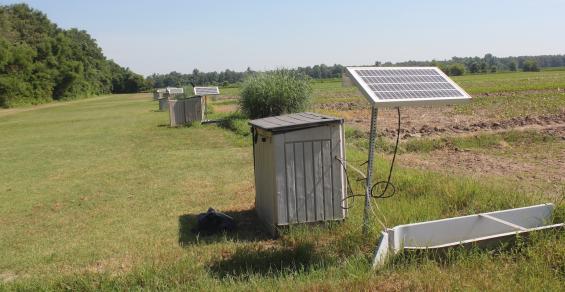A long-term research project in Arkansas has revealed significant reductions in sediment runoff by employing conservation practices, such as reduced tillage, cover crops and grass buffer strips at the field edge.
NOAA scientists forecast this summer’s Gulf of Mexico hypoxic zone or “dead zone” at 5,364 square miles. The good news is that it’s below the five-year average. However, it is still well above the 2035 target of less than 5,000 square kilometers.
Regardless of your feelings on agriculture’s contributions to the hypoxic zone, row crop production will most likely continue to face increased scrutiny to demonstrate environmental viability with respect to water quality. For cotton growers, the increasing demand for documented sustainability measures from buyers throughout the supply chain brings added pressure.
A long-term sustainability study at the Judd Hill Cooperative Research Station in Truman, Ark., is evaluating the impact of tillage and irrigation practices on cotton yield and water quality. Scientists Michele Reba and Arlene Adviento-Borbe with USDA-ARS and Tina Gray Teague with Arkansas State University are leading the project.
“Our goal is to understand how cotton production is contributing to excess nutrients in waterways and which practices can best reduce nutrient runoff without negatively impacting yield,” said Reba. She was speaking from the project’s research plots at the Arkansas Cotton Sustainability Field Day.
To date, the research has revealed significant reductions in sediment runoff by employing conservation practices, such as reduced tillage and cover crops. Researchers also observed the highest cotton yields in an irrigated conservation system.
Scientists Michele Reba and Arlene Adviento-Borbe with USDA-ARS and Tina Gray Teague with Arkansas State University share research results with visitors to the Cotton Sustainability Field Day.
Benefits of conservation system
The study treatment with the greatest soil and nutrient loss was the conventional system. A winter fallow plot that was re-bedded in the spring. Researchers also used an 8″ sweep plow to clear water furrow prior to the first irrigation. The edge of field was free from vegetation.
Compare that to the best treatment — a minimal-till plot with a terminated cereal rye cover crop. A narrow and shallow plow were used to clear water furrows. This treatment also featured a vegetative buffer, a grass strip near the field edge that contained fescue, Bermuda and perennial switchgrass.
When comparing the two treatments soil sediment concentrations were reduced 62% in the conservation system, while total suspended solids in the water were reduced by 80%.
Quantifying water quality
Quantifying water quality was the first step of the study. To do that, researchers installed 12 automated water samplers fed by H-flumes that collected water during irrigation or rain events. Samples were then analyzed in a laboratory.
An interesting finding was that the biggest runoff events with excess nutrients were not occurring during summer irrigation but during winter rains.
“That tells us we should plant cover crops,” Teague said. “Reducing nutrient runoff from fallow fields will lead to improved nutrient management and more sustainable cotton systems.”
Bill Robertson speaks to Cotton Sustainability Field Day visitors in a production cotton field at Judd Hill Foundation.
Sustainability
Visitors to the Sustainability Field Day also heard from cotton growers and industry leaders about the environmental and economic benefits of adopting conservation practices.
“Sustainability encompasses so much. It’s soil and water conservation, but it also means finding ways to keep farmers and those that use their products in business,” said Bill Robertson, Extension cotton agronomist for the University of Arkansas System Division of Agriculture.
The Global Sustainability Study 2021, conducted by global strategy and pricing consultancy Simon-Kucher & Partners, found significant global paradigm shifts in how consumers view sustainability and the associated generational differences in willingness to pay for sustainable products and services.
Globally, 85% of people indicate that they have shifted their purchase behavior towards being more sustainable in the past five years, the study found.




